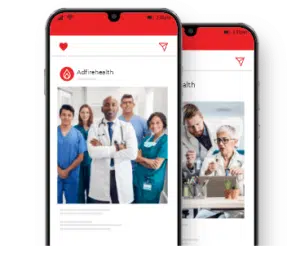You’ve heard of point-of-care advertising, right? You know, the pamphlets in the waiting rooms of doctors’ offices promoting a prescription drug or treatment method.
This advertising type was a pure brand awareness play by healthcare companies hoping to get consumers thinking about their product or service before seeing their HCPs. It’s been around for decades and probably always will be.
But that’s changing thanks to digital proliferation across the healthcare industry. Today, point-of-care advertising isn’t confined to healthcare advertisers vying for patients’ attention. It’s also evolved into a fantastic way to engage HCPs across mobile apps and EHRs, telehealth technology, and social media.

Want to Engage HCPs with Point-of-Care Advertising?
How HCPs Use Technology at Work
It’s crazy to think of a scenario when you’d go into your doctor’s office and not see them using technology. As younger generations usher in the next wave of HCPs, this isn’t going to change. The reality is that technology plays a massive part in the daily lives of HCPs and this opens the door for you to engage them with targeted ads.
Not convinced?
Mobile Apps & Electronic Health Record (EHRs) Are the Norm
Electronic Health Record apps (EHRs) are the primary way HCPs access patient information. A recent study from nearly 100M patient visits found physicians spent an average of 16 minutes and 14 seconds per patient using EHRs.1 The study found “[C]hart review (33%), documentation (24%), and ordering (17%) functions” accounted for most of the time spent, although the distribution of that time varies by speciality. HCPs are using non-medical-related mobile apps as well while they’re on breaks or on their way to and from work—think Reddit, The Weather Channel, My Fitness Pal, and Sudoku.

of an HCP’s time is spent on tasks indirectly related to patient care, including the use of EHRs/EMRs.
Telehealth & Other Emerging Tech Are on the Rise
During the COVID-19 pandemic, telehealth visits increased by 50%,2 and 76% of hospitals in the US are currently connecting with patients and consulting practitioners via video.3 These numbers should continue to rise as telehealth becomes a highly effective and efficient way to communicate in the post-pandemic world.
Even emerging technologies have their place in the modern HCPs’ professional life. Demand for virtual reality (VR) technologies,4 for example, is growing. Today, 80% of physicians said the market is heading toward VR. Furthermore, 60%-82% of patients ask their HCP about medication after viewing educational material through VR, which is another positive indication that the healthcare industry is going virtual.
Number of Telehealth Patient Encounters — United States, January 1–March 30, 2019 and January 1–March 28, 2020
Social Media is Becoming Common Among HCPs
Sixty-five percent of physicians use social media5 for professional purposes. Pharmacists, for example, frequently use social media to communicate with colleagues, while medical-focused social networks, like WebView, are gaining in popularity. Crowdsourcing among HCPs via social media is also common, which involves tapping into the medical community to solve problems or gather information and opinions. That said, they use it on off-hours, too. In fact, 90% of physicians use some sort of social media for personal activities.
The message to you should be clear: HCPs use technology at work, giving you the unprecedented opportunity to engage with them when they’re in “work mode” and are inherently more likely to respond favorably to medical-related content. Luckily, all of the devices and channels mentioned above have advertising capabilities you can tap into to enhance your point-of-care advertising strategy.
Implementing Point-of-Care Advertising
Now that you know the why behind point-of-care advertising, it’s time to understand how you can use this to your advantage and create 1:1 connections with HCPs.
Point-of-care advertising uses geofencing technology—similar to the technology Snapchat uses to deliver targeted geofilters—to give you the ability to provide programmatic media based on your target audiences’ physical location.
Here’s an example:
A medical device manufacturer is getting ready to launch a new implantable cardioverter defibrillator (ICD) and wants to build product awareness among cardiologists in their area.
Step #1: Compile a Target List
Any point-of-care strategy starts by compiling a target list. For this example, the advertiser would put together a list that included cardiologists or cardiology-related HCPs. This could include more senior HCPs who may be the decision-makers, NPPAs, affiliated care teams, hospital executives in purchasing, department heads at the hospitals; it just depends on the campaign’s objectives.
Not only should the target list include HCPs, but it should also include target locations. This could include hospitals that specialize in cardiology, private practices that focus on heart health, or other related specialists like electrophysiology and echocardiography.
Access NPI-level Data of 8MM+ HCPs
Step #2: Set a Targeting Radius
With a target list in hand, it’s time to set a targeting radius, which determines where (and when) your target audience will see your ads.
Let’s set a 25-mile radius here, which means HCPs in your target audience will only see your point-of-care ads when they’re in and around the target locations. Why a 25-mile radius? Because it ensures that the target audience sees the ads while they’re at the hospital, but also when they’re outside—maybe on a break—or at a restaurant nearby with colleagues after their shift. Essentially, it focuses the spend on times when these HCPs are in a professional mindset and before they disconnect and transition back into their personal life.
Step #3: Focus on NPI-Level Reporting
Ok, great. A target list and a target radius are in place. Now it’s time to measure and optimize your point-of-care campaign with NPI-level reporting.
Do cardiologists in one zip code have a higher CTR than those in another? Are pediatric cardiologists in the target list more engaged with social ads than cardiac surgeons? Are thoracic surgeons driving lower CPMs than cardiothoracic surgeons? NPI-level reporting provides the insights necessary to answer these questions. With these questions in hand, the advertiser can get a true 360° view of performance and improve media efficiency while investing more heavily in strategies that convert and drive sales lift. Now, this medical device manufacturer has a point-of-care campaign that’s both timely and relevant and more likely to drive engagement and conversions.
And the best part?
Point-of-care advertising can work for healthcare advertisers across the industry. Are you a medical supply company trying to increase sales of disposable facemasks? Great. Use point-of-care advertising to deliver timely and relevant ads to hospitals and doctors’ offices. Do you want to increase the number of demos for your new EKG machine? Cool. Set a radius around hospitals. What about a biotech company promoting a new vaccine or a pharma manufacturer promoting a new Rx drug? A point-of-care campaign targeted to PCPs could be an effective way to generate product awareness and sales lift.
